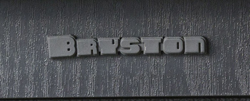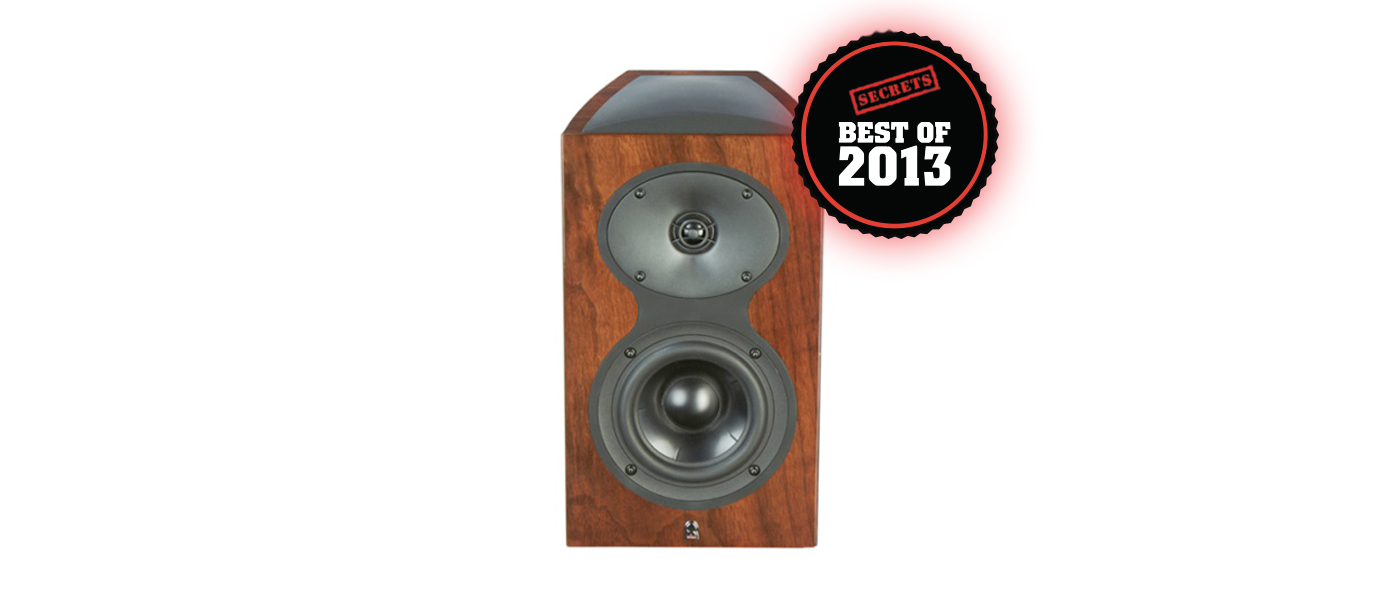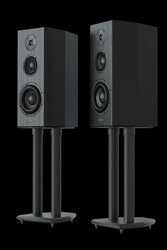
Introduction to the Bryston Mini-T Monitor Speakers
Bryston has a long history of manufacturing high quality amplifiers and digital components. Their products come with an industry leading warranty, reference-level sound quality, and above average build quality. For years their electronics have been paired with high end speakers at various shows, Thiel, Magnepan, PMC and other serious loudspeaker manufactures have chosen Bryston electronics to showcase their sound so I was very interested to hear that they were producing their own speakers.
Enlisting the help of another Canadian staple in HiFi, Axiom Audio, Bryston set out to design a speaker line with a big wish-list. The goal: create an entire matched line up of speakers with a high level of accuracy, detail and capable of high SPL’s without distortion or compression. And to that end, the speaker line up includes passive, active, and mid-size towers, 2 centers, 2 subwoofers, on-walls, in-walls and the “compact” Mini-T bookshelf reviewed here, all with custom drivers and well-built cabinets.

BRYSTON MINI-T MONITOR SPEAKERS SPECIFICATIONS
- Design: Three-way Monitor (Bookshelf) Speaker; Sealed Enclosure
- Drivers: One 1″ Titanium Dome Tweeter, One 4.5″ Aluminum Midrange, One 8″ Woofer
- MFR: 33 Hz to 22 kHz ± 3 dB
- Crossover Frequencies: 160 Hz, 2.3 kHz
- Nominal Impedance: 4 Ohms
- Sensitivity: 88 dB SPL @ 1 meter with 1 Watt (Anechoic)
- Maximum SPL: 100 dB SPL @ 1 Meter
- Recommended Power: 10 Watts to 200 Watts RMS
- Dimensions: 22.5″ H x 10.5″ W x 10.0″ D
- Weight: 39 Pounds/each
- MSRP: $2,695/pair Vinyl Veneer, $3,195/pair Wood Veneer, USD
- Bryston
- SECRETS Tags: Bryston, Speakers, Bookshelf Speakers, Monitor Speakers, Audio
Design and Setup of the Bryston Mini-T Monitor Speakers
Building a reference speaker line is no easy task and rather than re-invent the wheel they chose to enlist the team at Axiom Audio to help design and construct them. For good reason, Axiom has been designing, testing and building speakers for a very long time and they do it well. Bryston did not merely give Axiom a set of goals and a pile of cash, they worked extensively with Axiom to create this speaker line. After countless hours of anechoic testing, computer modeling and of course actually listening, Bryston has produced a solid first round of speakers.
All the speakers in the line up are built with heavily braced MDF cabinets with non-parallel walls, 1.5″ baffles and are covered in vinyl wrapped veneers (hardwood available at extra cost). The Mini T is a rear-ported 3-way design using a custom 1″ titanium-dome tweeter, ceramic-coated composite aluminum 5.25″ midrange and 8″ woofer which both feature cast-aluminum baskets. All drivers are carefully matched and chosen to achieve high SPL without distortion. These bookshelf speakers are anything but mini and weigh in at over 40 pounds each. They have a rated response of 33 Hz – 20 kHz, a sensitivity of 86dB and a nominal impendence of 4 ohms. The binding posts are machined from solid brass which is then gold plated, including the nuts and washers.
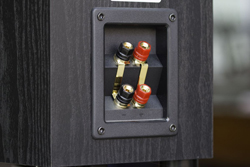
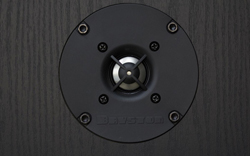
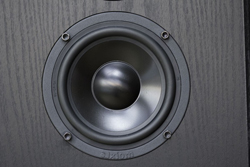
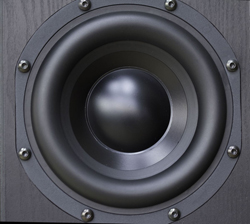
I moved the Minis (no easy feat!) into the position normally occupied by my MartinLogan Vista Electrostatic speakers, using sand-filled metal stands. Power came from a Marantz PM8003 integrated amp and an Oppo BDP-105 was used for SACD playback and as a USB DAC for my HTPC.
The speaker location put the speakers 2′ from the wall, 7′ apart and the closest side wall was over 6′ away. The listening position was 8′ from the speakers. This room is large and open on 3 of the 4 sides, which creates a challenge with mid to low bass.
The Bryston Mini-T Monitor Speakers In Use
For most reviews of high end equipment I usually dig into my standard audiophile-quality releases as this allows the best qualities to shine through. However in the informal listening sessions done in the first few weeks I found a strange occurrence with the Bryston Minis. They sounded good with the majority of my music, not just the best recorded stuff. As such this review is a slight departure from my norms as I found myself listening to music that I normally pass by. I have a large and varied collection of music and the high quality audiophile grade recordings amount to a small fraction. These are easily surpassed in numbers by standard quality and even low quality albums. These still contain fantastic music-problem is on many high end systems they sound flat, lifeless and I end up hearing the flaws rather than enjoying the music. What shocked me with the Brystons was how much of my collection was fun to listen to again.

I started my review with an excellent pressing of an aggressive recording, Pixies Doolittle on SACD by Mobile Fidelity. This recording is brutally honest, and while the SACD is miles better than the CD version it is easily unplayable on the wrong system. The top end can be hot and sterile with overly clinical speakers (B&W 804s come to mind) and if the mid-bass is not accurately reproduced you are left with a thin fatiguing presentation. The first thing I noticed with this album was how smooth the top end was. This recording can often sound harsh, yet even at loud volumes there was a smooth high frequency response. The kick drums were solid and had real impact, and Kim Deals Bass guitar was perfectly balanced.

Next up was a normally unlistenable album, M.I.R.V.’s Feeding Time on Monkey Island. This obscure alternative rock album is chocked full of distorted guitars, vocal filters and post-production effects. Granted there are little to no soundstage cues and the wide amount of effects used to create the overall sound makes this about as far from audiophile quality as one can get. With my electrostatics this recording is fatiguing and lacks impact and detail, yet through the Bryston Mini T’s I was able to hear the intricate drum beats and funky bass lines throughout all the muck. There was deep bass that normally would require a subwoofer to hear. I was very impressed with the output produced and could hear no detrimental compression from the drivers.

Moving on, I wanted to cleanse the system a bit and put on a very raw recording from Annie and The Beekeepers In The water. Available online at www.mastersfromtheirday.com it is a 24bit recording done with minimal compression or post processing. This song, due to its raw nature can really stress a system. With some loudspeakers, including my own MartinLogans, there can be compression at high volumes. Once you hear the dynamics being squashed it is easy to recognize yet I found no limit what so ever with the Mini T’s and for the first time in my system was I able to exceed my comfort level before I heard any driver breakup or distortion. The banjo had a real-life dynamic punch, and if you have ever heard a live banjo up close you will understand just how dynamic it can be.

Moving on to some electronic based music, I moved to the unique sound of Blockhead. Specifically the melancholy Triptych Pt.3 found on his Music By Cavelight album. This song opens with a somber piano riff that is soon followed by a strong electric bass-guitar line. This bass when done right, as the Minis were capable of, is detailed and full with strong impact. When done wrong it can overwhelm the vocal track and muddy up the whole presentation. I was floored with the sheer amount of deep bass produced by the minis. There was nothing mini about it.

And finally I went to another electronic mix, this one by Nightmares on Wax, – Gambia Via Vagator Beach. Unlike the Blockhead track this one mixes actual percussive instruments with electronic samples. On this track there are two different hand-drums being played in different positions, which the Minis could track easily, the depth and width of the soundstage exceeded the physical boundaries. The highs were crystal clear without fatigue and when the electronic bass comes in around the half way mark I almost fell off my seat. I have never heard this amount of bass without the aid of a subwoofer in my listening room. The closest I have ever come was with the $14,000 MartinLogan Summit X and their combined four 10“ powered woofers. While the Minis do not have nearly the same beautiful midrange as those flagship hybrids, they easily matched them in the bass department. Even though the Minis use a ported enclosure I could hear no port noise. There was clear definition and impact in the bass notes and the midrange never overpowered the frequency balance.
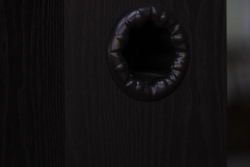
Conclusions about the Bryston Mini-T Monitor Speakers
The Bryston Mini T Bookshelf speakers provided deep bass, full clean and not over-bearing, and well defined midbass which is not easy in my room. Midrange slightly recessed overall compared to some box speakers, which is a compliment. With clean treble that was never fatiguing. Most surprising was the speakers’ ambivalence toward the source material, unlike some higher-end speakers I have reviewed.
I found it hard to find fault with the sound of these speakers. However at their price point I feel they don’t look the part. That is purely superficial, and I know it. However the $2500 speaker market is full of great sounding, and great looking speakers. For that price I was surprised not to find real wood veneer (available for an upcharge with all the Bryston speakers for only $500). Make no mistake, while that is purely aesthetic it is part of the overall package. If you can look past the sonic-insignificance of fine finishing and audio jewellery and give these speakers a listen you will be very pleased. This is the first round of speakers for Bryston and given the excellent sound quality I would be surprised to hear it was their last.
